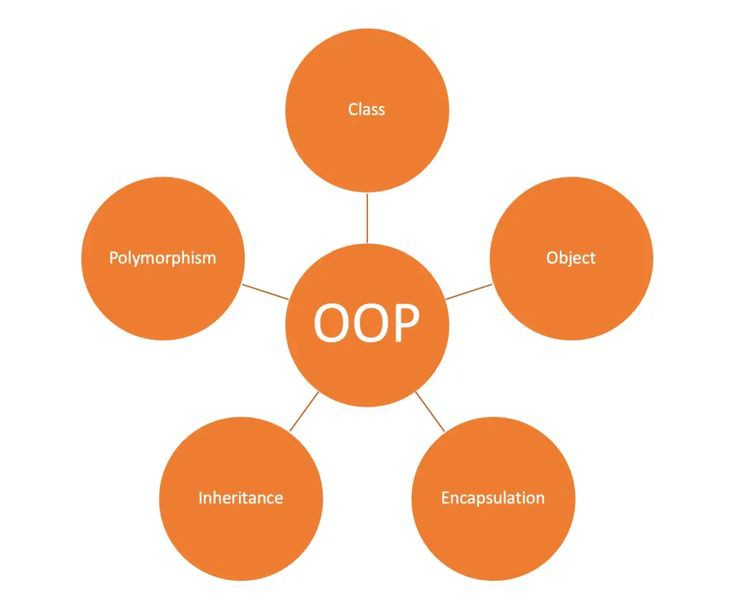Programming languages have evolved over the years. These languages are used to build mobile applications, web apps, and software programs. The digital world uses technology and programming to solve real-life problems.
Object-Oriented Programming is a game-changer in the tech world. It has gained significant reputation because of its capacity to model real-life situations in a clear and organized way using code.
If you’re new to programming or looking to delve into object-oriented programming, this article will provide you with a stable foundation to understand its principles and ideas.
Table of Contents
What is Object-Oriented Programming (OOP)?
Object-oriented programming (OOP) is a programming paradigm that organizes code around objects rather than functions and methods. In simpler terms, OOP lets you shape your code to mirror how we consider and interact with the world.
Object-oriented programming began in the 1960s and 1970s with computer science research. Ole-Johan Dahl and Kristen Nygaard created Simula, the first object-oriented language, in 1967. Simula introduced OOP’s key concepts—classes, objects, inheritance, and polymorphism.
Alan Kay and his Xerox PARC colleagues created Smalltalk in 1972. Smalltalk was the first pure object-oriented language, including numbers and functions as objects. Alan Kay introduced object-oriented programming (OOP) as a programming language paradigm.
In object-oriented software, code can be organized into reusable components with shared characteristics or actions. Object-oriented programming enhances developers’ ability to maintain and manage applications. It promotes reusability, modularity, and a clearer code outlook, making managing it less complicated.
Object Oriented Programming Concepts
If object-oriented programming is new to you, there are basic concepts you need to know. At the centre of Object-Oriented Programming are two fundamental ideas: objects and class.
-
Objects
OOP models real-world objects with “objects”. Objects encapsulate classes (attributes) and behaviour (techniques) into a complete unit. Objects make it less complicated to manipulate massive amounts of code and to create reusable components. OOP objects have states and behaviours. In Java, an object’s state is its variable value at any given time, and its behaviour is implemented as a method.
-
Classes
An object is an example of a class, and a class is a blueprint or template for developing items. Classes are blueprints or templates for objects that specify their properties and behaviour without really existing. Individual instances of a class are called objects, and a class can have many objects. Since all instances share static variables and methods, they are not object-oriented.
An example of OOP in objects and classes is having a class classified as expensive cars. The instance of objects can be Mercedes-Benz, BMW, Toyota, Tesla, Ford, Audi, Hyundai, and Ferrari.
Read also: 10 Tips to Consider When Selecting the Best Laptop for Programming.
The Four Pillars of Object-oriented Programming
Object-oriented programming is based on four key concepts. They are Encapsulation, Inheritance, Polymorphism, and Abstraction. These concepts are called OOP Principles and pillars.
-
Encapsulation
Encapsulation is the concept of bundling information and techniques together within an item. It helps to protect the data from being accessed or changed by unauthorized approaches. Encapsulation is the concept of bundling the statistics (attributes) and the techniques (functions) that perform at the facts into a single unit, referred to as a category.
This facilitates organizing and structuring code, making it into an object to simplify and reuse code.
Encapsulation wraps an object’s data (properties) and behaviour (methods) into a class (or interface). Simply put, encapsulate implies to be encased in a capsule. Java puts everything in a class or interface, unlike C and C++, which allow global variables.
Encapsulation hides irrelevant data from class users and exposes just the necessary elements.
-
Inheritance
Inheritance allows classes to inherit attributes and methods from a different class. This makes it possible to create hierarchies of classes. Inheritance is a mechanism that permits a class to inherit the properties and behaviours of every other elegance.
The inherited class is known as the base or determined elegance, and the class that inherits is the derived or infant class. This promotes code reusability and establishes a hierarchical courting among training. You can reduce unnecessary code by inheriting functions and data from other classes.
-
Polymorphism
Polymorphism allows objects of various classes to reply to the equal method call in one-of-a-kind ways. This makes it feasible to jot down code that can work with some unique objects without understanding their individual types.
-
Abstraction
Abstraction is the procedure of hiding the implementation details of an objects. This makes it viable to create a more widespread motive code that can be used with many distinct objects. The abstract shows only what is necessary within the code.
In simple terms, abstract works like this. You have a car; you start the engine to go on a journey. You don’t need to know all the components of a car for it to start. Abstraction simply hides the details, but the car works.
Based on the four pillars of Object-Oriented Programming, you need to know how to get started.
Getting Started with Object-oriented Programming
If you are new to object-oriented programming, some resources will help you get started. There are many books, tutorials, and online guides to be had which could teach you the basics of object-oriented programming.
You can also locate several open-source object-oriented programming tasks that you may use to learn from and practice your capabilities.
-
Online tutorials
Object-oriented programming languages require practice and understanding of basic concepts. There are online tutorials from learning platforms like Udemy, LinkedIn Learning, edX, Datacamp, Coursera, Udacity, and CodeCademy.
YouTube is another source of learning OOP. There are several tutorials from different perspectives in different languages to teach object-oriented programming. Some offer full training from fundamentals to advanced levels.
-
Websites and blogs
Tutorialspoint, GeeksforGeeks, Freecodecamp, Hashnode, Hackernoon, Medium and Web.Dev have written content on blogs to teach object-oriented programming. Writers with diverse experiences in object-programming languages provide solutions to problems and understanding of code.
Some of these writers are subject matter experts who have worked with corporate companies and have built projects using these languages.
-
Training institutes
Training Institutes offer courses with mentors and trainers who can offer guidance on the learning path for object-oriented programming concepts. These trainers can provide real-life object-oriented programming examples to enhance learning.
-
Online communities
Online communities have been proven to help programmers build projects faster. Developers, software engineers, and programmers are part of communities for better opportunities. Network with these experts found in online communities. Contribute to the communities and learn.
-
Education
Studying in school with courses such as Computer science, computer engineering, and Information technology (IT) provides open learning to object-oriented programming languages like Java, Python, and C++.
-
Certifications
Online Platforms like Udemy and Coursera provide certifications of completion to show expertise in object-oriented programming. Certifications are great ways to get started with object-oriented programming. They also help provide opportunities and jobs and show expertise on social media platforms.
Object-Oriented Programming Languages
The object-oriented programming model is the basis of an OOPL. Object-oriented programming supports many popular programming languages, which include Java, Python, C++, C#, Simula, and Smalltalk.
Here are a few examples of ways object-oriented programming is utilized in those languages:
-
Java
Java is a popular language for building applications. Object-oriented programming is used significantly in Java to create modular, maintainable, and scalable packages. Furthermore, Java is a general-purpose language. It runs on Windows, Mac, and Linux with Notepad++ and Android Studio.
Java is used to develop desktop apps and web apps. Java helps build mobile applications for Android. Java can be used with Xtensible Markup Language (XML) to build mobile apps.
Also, Java is used for big data processing, embedding systems, and building web and app servers.
-
Python
Python is a famous language for web development and data science. Object-oriented programming is utilized in Python to create reusable components and to control complicated statistics structures. Python works with classes and methods.
Python may be used to develop desktop apps for Windows and MacOS. It is helpful for data science with Pandas. Developers use Python for artificial intelligence, data engineering, and machine learning.
Read also: Python for Beginners: Advantages of Learning Python Programming Language.
-
C++
C++ is a powerful language developed in 1979. C++ makes use of object-oriented programming to create efficient and practical applications. C++ is a superset of C language. C++ is a general-purpose language used to build web browsers and operating systems.
C++ is a complex language and requires understanding. C++ provides safety, speed, increased performance, and a built-in library. Because of this, C++ is useful for demanding tasks.
-
C#
C# is a famous language for developing Windows programs. C# uses object-oriented programming principles like abstraction and encapsulation. It is used to create user-friendly applications. C# is popularly used with .NET to build programs.
Join our WhatsApp community to access opportunities and resources that will fast-track your career growth.
Benefits and Application of Object-oriented Programming
Object-oriented programming languages have many advantages over different programming paradigms, consisting of the following:
-
Modularity
Object-oriented programming languages make it easier to break down massive packages into smaller, extra potential modules. This can make the code easier to apprehend, broaden, and preserve.
-
Reusability
Object-oriented programming code is often more reusable than procedural code. This is because training can be inherited and reused in unique elements of a program. So codes can be reused in loops.
-
Maintainability
Object-oriented programming code is frequently simpler to preserve than procedural code. This is because modifications to one magnificence may be localized and no longer affect other program components.
-
Security
Object-oriented programming supports the security of code and applications.
-
Software development
Object-oriented programming is a crucial software development paradigm. It’s used for software development. OOPs emphasize code reuse, encapsulation, and modularity to construct scalable, maintainable, and efficient programs. Developers seeking reliable software solutions use OOP as the technology evolves.
-
Game development
Object-oriented programming is used for game development because of its capability to imitate games as objects. Complex interactions among humans, gadgets, and the environment are essential in video games.
Developers can use OOPs to define those entities’ behaviours and attributes by describing them as objects. Object-oriented programming helps developers create thrilling and user-interactive games.
-
Database management systems
Database management systems (DBMS) employ OOP principles, including encapsulation and abstraction. Database interaction is simplified in OOP.
Languages such as Python and Java using tools consisting of JDBC and SQLAlchemy. Database systems use objects that help improve code organization and management.
-
Mobile app development
OOPs are regularly used to improve mobile apps, which power popular platforms like Android and iOS. OOPs-compliant languages such as Java and Swift allow builders to develop compelling mobile applications.
Read also: Who is a Network Engineer and How Do You Become One?
How to Improve With Object-Oriented Programming Languages
Object-Oriented Programming is a powerful paradigm with unlimited software development possibilities. Beginners should keep studying and practising these concepts:
-
Practice
Writing code is the most excellent method to learn OOP. Create projects, use OOP languages, and try different scenarios.
-
Read documentation
Learn programming languages and libraries’ documentation. Understanding standard libraries and frameworks improves development efficiency.
-
Team up and learn
Participate in open-source and coding competitions. Join boot camps and hackathons to get better. Find communities online to find solutions to problems and opportunities. Learning from seasoned developers and contributing to real-world projects is valuable.
-
Stay updated
Technology advances quickly. Keep current with OOP and programming language advances.
-
Examine design patterns
Understand Singleton, Factory, and Observer design patterns. Common programming problems have reusable solutions.
-
Build projects
Build projects with languages like Java and Python. This builds your portfolio and hands-on experience with object-oriented programming concepts. You can build web, mobile, and desktop apps with these languages.
Create basic projects like calculators and games and test them. This will enhance your skills and knowledge in OOP.
Conclusion
Object-oriented programming is an effective and flexible paradigm that can be used to develop a wide range of software programs. OOP skills improve with practice.
OOP concepts will help you become a good coder whether you want to be a software developer, data scientist, or engineer. Explore, experiment, and learn more about coding.
Do you want to stay updated on the latest happenings in Tech, Business, Campus and many more? Then, subscribe to our newsletter.
About Author
-
Hi. I'm Temitope Victoria, a technical writer with a strong foundation in computer science.
I'm passionate about writing engaging articles that enlightens readers on latest technologies.
My interests span across women, technology and lifestyle and entrepreneurship.
Latest entries
 TechnologyDecember 13, 2023A Beginner’s Guide to Object-Oriented Programming
TechnologyDecember 13, 2023A Beginner’s Guide to Object-Oriented Programming TechnologyNovember 22, 2023Who is a Network Engineer, and How Do You Become One?
TechnologyNovember 22, 2023Who is a Network Engineer, and How Do You Become One? Business InsightsNovember 7, 202310 Top and Emerging Delivery Companies in Nigeria
Business InsightsNovember 7, 202310 Top and Emerging Delivery Companies in Nigeria

